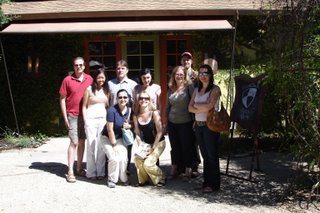Crushed: Why Working at a Winery Rocks
With three weeks of hindsight under my belt after finishing my first crush as a winery (the great zin house known as Dashe Cellars, in Oakland), I'm prepared to offer the following pearls of wisdom to anyone who may be considering this experience in the future:
1.) It's great.
2.) Do it.
When I began looking into the internship, my goal was more or less to try something new and "diversify" the ways in which I was spending my time (yes, I've been reading too many financial web sites lately). Deviating 180 degrees from sitting in front of a computer all day was no easy task. The opposite of sitting on your butt is moving around, so I had to come up with a plan that involved physical activity (or "labor," if you will) without negating the point of the experience (e.g: by signing on to work an assembly line somewhere; three months of blowing acid off parts in an air compressor plant, way back in the university days, burned me clear of factory work for life). I also wanted to delve into somethng I was truly interested in. My options came down to 1.) working retail in a gallery; probably easier said than done w/o an art history degree and/or a rolodex of contacts and 2.) looking for internships in cool industries. Luckily for me, many wineries hire "interns" to help out and schlep during harvest, and for the right winemaker, enthusiasm is an acceptable substitute for experience. I stumbled across a craigslist ad for Dashe Cellars, and I signed on up.
The internship lasted two months, from about the last week of August through the first two weeks of October. On my first day in the winery, I was instructed on the art of mixing vats of chemicals (peroxycarb and citric acid, used primarily for sanitation), attaching hoses to tanks, using the ozone machine, and powerwashing barrels. I worked for 13 hours straight, and I fell into bed that night with a fatigue I had never known before.
The next day, I worked 11 hours, and was assigned to man the bin dumper at the sorting table. The bin dumper is literally what it sounds like -- a giant metal frame that holds a 1/2 ton bin of grapes at a time, with a top that tilts forward to unload the cargo onto a conveyor belt a couple feet below. My skills at the switch that controlled the rate of dumpage (and hence, whether the load gently settled onto the table at a consistent pace, or "whumped" onto the table in one solid heap, often clogging the hopper through which they passed) were rickety and unsure, and there were more "whumps" than anyone cared to hear. By the end of the day...I hadn't improved much. I was still whumping all over the place.
Over the next seven weeks, we periodically received batches of zin, with smaller amounts of petite syrah, cab and riesling also appearing intermittently. The length of our days varied according to the tonnage of fruit that arrived. Four or eight tons was no sweat. Ten, 12 or 14 meant ending the day on a floodlit crushpad after sundown, and hosing off the equipment in a chillier-than-desired air temp.
When we weren't crushing, we pumped over the juice already in tank. Many 1200 gallon batches of zin, cab and petite needed to be aerated twice a day, and the heavy duty pumps (and their spaghetti networks of hoses) used for the endeavor need a thorough sanitation bath after use. Towards the end of harvest, as fewer grapes were coming in and more worked their way through tank fermentation towards their barrel slumber, our daily routine focused less on pumping over and more on adding yeast (innoculating), shoveling tanks (essentially, climbing into a tank w/ a shovel to remove the skins; the fermenting wine was first transferred to another tank, and then the skins were taken to a press, where the last of the juice could be extracted) and "barrelling down," which meant transferring wine from their stainless steel tanks into oak barrels.
I also spent about an hour and a half, on most days, measuring the sugar levels (or brix) of each batch of wine with a variety of hydrometers. On occasion, I would attempt to make my way through the series of steps necessary to measure TA (total acidity) - though I never quite got the color change right. I administered hot, frothy pill tests on wines that were almost "dry" (meaning their sugar levels were very low, indicating that they were almost finished with fermentation) to check for residual sugar. And on my final day in the winery's lab, I mixed a cocktail of sample wine, hydrogen peroxide and a phosphate compound for a purpose that I cannot remember. It was just like high school chem lab.
I could go on about all the lesser tasks to which I was assigned during my tenure at Dashe, but descriptions are eluding me, and you might quickly grow bored. Suffice it to say that the following lessons were carried away: There is a LOT of work involved in getting the juice out of those grapes and turning them into the complex, nuanced, nectar that wine lovers so ardently worship. Much of the effort is tedious and physical -- it's been said that winemaking is 90% sanitizing, 8% waiting, and 2% beer -- and mother nature can be very uncooperative. On the other hand, the winemaker's role as a craftsman is indisputable, and the satisfaction apparent on the growers' faces as they discuss the quality of the 2007 vintage gives new meaning to the phrase "salt of the earth".


